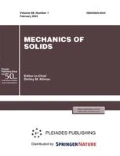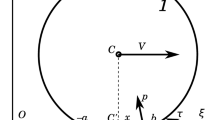Abstract—
The indentation of a rigid cylinder with a flat base into a viscoelastic layer situated without friction on a rigid base is considered. The interaction process consists of two stages: indentation of a cylinder at a constant speed to a certain depth and its further holding in this depth. The mechanical behavior of a viscoelastic layer is described by equations of linear viscoelasticity with relaxation functions of two types: exponential and power. The solution of the problem is based on the application of the Volterra principle and the use of an elastic solution constructed by the asymptotic “methods of large and small λ” that were developed by I. I. Vorovich and his students. On the basis of the solution obtained, the nature of the time variation in contact stresses and loads during the indentation of the cylinder has been studied for both relatively small and relatively large layer thicknesses. A comparison of the time variation of the studied quantities for two different relaxation functions and with the results of calculations based on a simplified one-dimensional model used to describe the behavior of a viscoelastic layer during indentation is performed.
Similar content being viewed by others
REFERENCES
I. I. Vorovich and I. A. Ustinov, “Pressure of a die on an elastic layer of finite thickness,” J. Appl. Math. Mech. 23 (3), 637–650 (1959).
V. M. Aleksandrov and I. I. Vorovich, “The action of a die on an elastic layer of finite thickness,” J. Appl. Math. Mech. 24 (2), No. 2, 462–476 (1960).
V. M. Aleksandrov, “On the solution of certain contact problems of the theory of elasticity,” J. Appl. Math. Mech. 27 (5), 1490–1494 (1963).
I. I. Vorovich, V. M. Aleksandrov, and V. A. Babeshko, Nonclassical Mixed Problems of the Elasticity Theory (Nauka, Moscow, 1974) [in Russian].
I. Argatov and G. Mishuris, “An analytical solution for a linear viscoelastic layer loaded with a cylindrical punch: evaluation of the rebound indentation test with application for assessing viability of articular cartilage,” Mech. Res. Comm. 38 (8), 565–568 (2011).
I. Argatov, “An analytical solution of the rebound indentation problem for an isotropic linear viscoelastic layer loaded with a spherical punch,” Acta Mech. 223, 1441–1453 (2012).
W. C. Hayes, L. M. Keer, G. Herrmann, and L. F. Mockros, “A mathematical analysis for indentation tests of articular cartilage,” J. Biomech. 5 (5), 541–551 (1972).
X. Zhu, L. Liu, Z. Wang, and X. Liu, “Axisymmetric contact problem for a flattened cell: contributions of substrate effect and cell thickness to the determination of viscoelastic properties by using AFM indentation,” Scanning 2017, 11 (2017).
P. D. Garcia and R. Garcia, “Determination of the viscoelastic properties of a single cell cultured on a rigid support by force microscopy,” Nanoscale 2018 (10), 19799–19809 (2018).
Y. Cao, D. Ma, and D. Raabe, “The use of flat punch indentation to determine the viscoelastic properties in the time and frequency domains of a soft layer bonded to a rigid substrate,” Acta Biomater. 5 (1), 240–248 (2009).
A. Lyubicheva, “Closed-form solution of axisymmetric contact problem for a viscoelastic base within cycle of increasing and decreasing of load on the indenter,” J. Frict. Wear 38 (2), 138-143 (2018).
I. G. Goryacheva, M. Z. Dosaev, Y. V. Selyutskiy, et al., “Control of insertion of indenter into viscoelastic tissue using a piezoelectric drive,” Mekhatr. Avtomat. Uprav. 21 (5), 304-311. (2020).
A. Yakovenko, I. Goryacheva, and M. Dosaev, “Estimating characteristics of a contact between sensing element of medical robot and soft tissue,” in New Trends in Mechanism and Machine Science, Vol. 43 (Springer, 2017), pp. 561–569.
Yu. N. Rabotnov, Creep of Structural Members (Nauka, Moscow, 1966) [in Russian]
V. M. Aleksandrov and D.A. Pozharskii, Nonclassical Spatial Problems in Mechanics of Contact Interactions between Elastic Bodies (Factorial, Moscow, 1998) [in Russian].
Yu. N. Rabotnov, Elements of Hereditary Solid Mechanics (Mir, Moscow, 1980).
N. I. Malinin, “Creep and relaxation high polymers in transient state,” Prikl. Mekh. Tekhn. Fiz., No. 1, 56–65 (1961).
Funding
This study was supported by the Russian Science Foundation, grant no. 18-19-00574.
Author information
Authors and Affiliations
Corresponding authors
Additional information
Translated by A. A. Borimova
About this article
Cite this article
Goryacheva, I.G., Yakovenko, A.A. Modelling of Cylinder Indentation into a Viscoelastic Layer. Mech. Solids 55, 654–663 (2020). https://doi.org/10.3103/S0025654420050088
Received:
Revised:
Accepted:
Published:
Issue Date:
DOI: https://doi.org/10.3103/S0025654420050088




